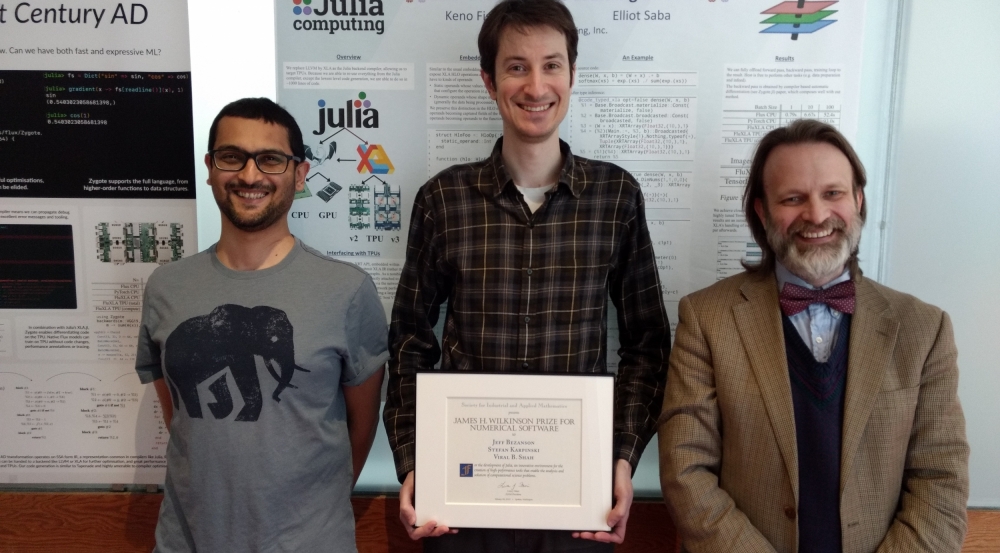Wilkinson Prize goes to developers of flexible Julia programming language
Programmers developing applications for fields as diverse as astronomy, economics, artificial intelligence, energy optimization, and medicine often found themselves creating software with languages that offered slow computation. But in this era of big data, dynamic, flexible, and easy-to-implement code is required for programmers to efficiently build high-performance software tools needed for intensive data analysis. Enter Julia, an open-source language for advanced technical computing and data science.
Research on Julia began in MIT's Computer Science and Artificial Intelligence Laboratory (CSAIL) and its Department of Mathematics under the guidance of Alan Edelman, a professor of mathematics, and founding sponsor Jeremy Kepner, a Fellow at MIT Lincoln Laboratory. Three researchers at MIT who were creating the initial version of Julia in 2009 — Jeff Bezanson, Stefan Karpinski, and Viral Shah — were named the recipients of the 2019 James H. Wilkinson Prize for Numerical Software.

This highly competitive prize is awarded once every four years to recognize authors of "innovative software in scientific computing" and to encourage emerging research talent in computer science. The selection committee for the prize said that the Julia codevelopers have allowed researchers "to write high-level code in an intuitive syntax and produce code with the speed of production programming languages."
Julia was launched publicly in 2012 as an open-source product. Since then, Julia has been downloaded upwards of three million times and is used in more than 1,500 universities for scientific and numerical computing — MIT, Stanford, and the University of California Berkeley, to name a few. Being open source with the liberal MIT license, Julia has attracted a large community. More than 800 programmers have contributed to Julia, and many more have contributed to an ecosystem that includes at least 2,500 packages. The project lives online at https://julialang.org with development carried out on GitHub and discussions on Discourse and Slack.
Staff at Lincoln Laboratory were some of the early adopters of the Julia language. Developers of an advanced collision avoidance system, ACAS X, for both manned and unmanned aircraft used Julia in creating the machine learning algorithms that determine the decisions and resulting warnings the system issues to pilots and air traffic managers. ACAS X prototypes are under evaluation by the Federal Aviation Administration as a replacement for the current collision avoidance system used worldwide by all large aircraft.
Currently, researchers across Lincoln Laboratory are using Julia in the refinement of ACAS X capabilities and in the development of various other systems, such as one to compare DNA signatures. At MIT, the Julia Lab within CSAIL is supporting several efforts, using Julia to develop programs to analyze data from clinical trials of new drugs and building climate models that learn automatically from diverse data sources.
During the Society for Industrial and Applied Mathematics (SIAM) Conference on Computational Science and Engineering held in Spokane, Washington, between February 25 and March 1, the Julia cocreators accepted the James H. Wilkinson Prize for Numerical Software. A video of the prize ceremony can be seen on YouTube. The prize recipients are founding partners and current principals at Julia Computing, a firm that provides products, training, and consulting to help organizations take advantage of Julia's high performance and ease of use.